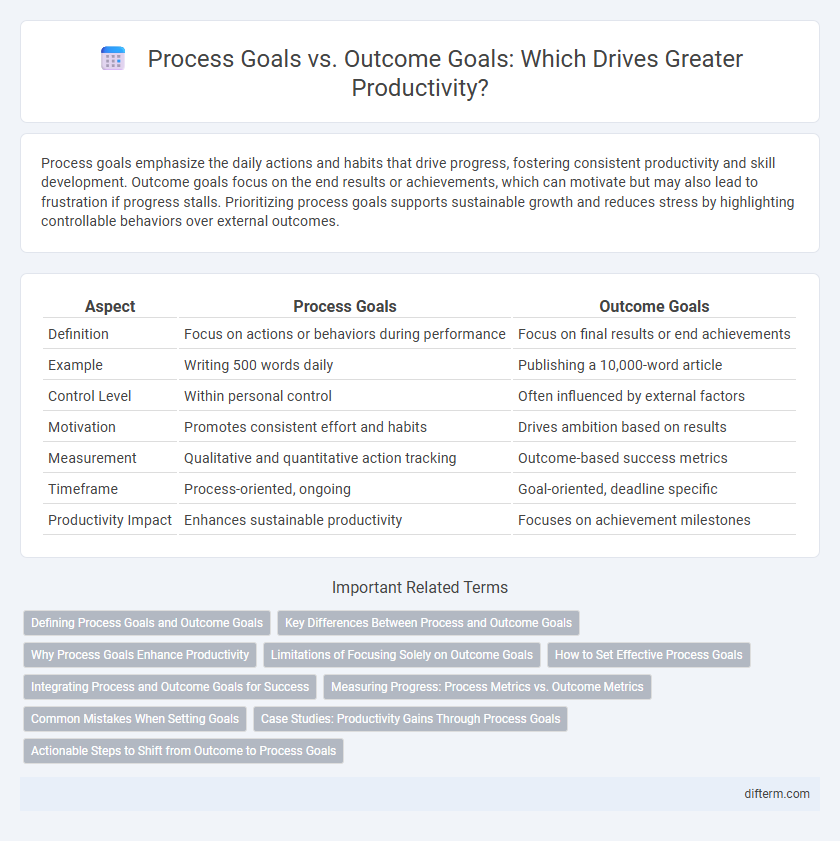Process goals emphasize the daily actions and habits that drive progress, fostering consistent productivity and skill development. Outcome goals focus on the end results or achievements, which can motivate but may also lead to frustration if progress stalls. Prioritizing process goals supports sustainable growth and reduces stress by highlighting controllable behaviors over external outcomes.
Table of Comparison
| Aspect | Process Goals | Outcome Goals |
|---|---|---|
| Definition | Focus on actions or behaviors during performance | Focus on final results or end achievements |
| Example | Writing 500 words daily | Publishing a 10,000-word article |
| Control Level | Within personal control | Often influenced by external factors |
| Motivation | Promotes consistent effort and habits | Drives ambition based on results |
| Measurement | Qualitative and quantitative action tracking | Outcome-based success metrics |
| Timeframe | Process-oriented, ongoing | Goal-oriented, deadline specific |
| Productivity Impact | Enhances sustainable productivity | Focuses on achievement milestones |
Defining Process Goals and Outcome Goals
Process goals focus on the specific actions and behaviors needed to achieve desired results, such as dedicating 30 minutes daily to writing. Outcome goals emphasize the final result, like publishing a book or achieving a sales target. Defining clear process goals helps maintain consistent progress and build productive habits, while outcome goals provide directional motivation and measurable benchmarks.
Key Differences Between Process and Outcome Goals
Process goals emphasize daily behaviors and actions, such as dedicating specific hours to work or following a structured routine, which facilitate consistent productivity. Outcome goals focus on the end results, like completing a project or achieving sales targets, providing clear milestones but often dependent on external factors. Understanding the distinction between process and outcome goals enables more effective goal-setting strategies by balancing controllable actions with desired achievements.
Why Process Goals Enhance Productivity
Process goals emphasize daily actions and habits, fostering consistent progress and reducing procrastination. By targeting controllable behaviors, process goals increase motivation and sustain momentum, leading to higher overall productivity. This focus on actionable steps helps individuals maintain clarity and adapt strategies, maximizing efficiency and goal achievement.
Limitations of Focusing Solely on Outcome Goals
Focusing solely on outcome goals often leads to neglecting the actionable steps necessary for progress, resulting in decreased motivation and incomplete task execution. Outcome goals can create pressure and anxiety, reducing productivity by shifting attention away from the process improvements that drive long-term success. Emphasizing process goals promotes consistent habits and skill development, which are crucial for sustainable achievement and overcoming obstacles.
How to Set Effective Process Goals
Setting effective process goals involves identifying specific, actionable steps that directly influence daily behavior and workflow efficiency. Prioritize measurable activities such as time management strategies, task prioritization, and routine optimization to ensure consistent progress. Process goals enhance motivation and adaptability by emphasizing control over actions rather than uncertain results, thereby improving overall productivity.
Integrating Process and Outcome Goals for Success
Integrating process and outcome goals enhances productivity by aligning daily actions with long-term objectives, ensuring consistent progress and measurable results. Process goals, such as completing specific tasks, drive sustained effort, while outcome goals, like achieving sales targets, provide clear benchmarks for success. Combining these goal types fosters motivation and adaptability, creating a balanced strategy that maximizes performance and achievement.
Measuring Progress: Process Metrics vs. Outcome Metrics
Process goals emphasize tracking daily actions such as hours worked or tasks completed, using process metrics like time spent and consistency to measure progress. Outcome goals focus on the end results, such as sales targets or project completion, relying on outcome metrics like revenue generated or milestone achievement. Measuring progress through process metrics ensures continuous improvement and adaptability, while outcome metrics validate overall success and goal attainment.
Common Mistakes When Setting Goals
Setting process goals often leads to higher productivity compared to outcome goals because they emphasize daily actions and habits rather than just results. Common mistakes include setting vague outcome goals that lack specific, actionable steps causing motivation to wane over time. Failing to align process goals with measurable milestones decreases accountability and hampers consistent progress.
Case Studies: Productivity Gains Through Process Goals
Case studies reveal that focusing on process goals, such as adopting time-blocking techniques or implementing daily prioritization, leads to consistent productivity gains by enhancing workflow efficiency. Employees practicing process-oriented approaches report higher task completion rates and reduced procrastination compared to those fixated solely on outcome goals like project deadlines. This shift towards process goals cultivates sustainable work habits and incremental progress, driving measurable improvements in overall productivity.
Actionable Steps to Shift from Outcome to Process Goals
Shifting from outcome goals to process goals enhances productivity by emphasizing actionable steps instead of final results. Setting specific, measurable tasks such as daily work targets or skill improvements fosters consistent progress and motivation. Tracking behaviors and habits rather than outcomes creates a sustainable workflow that drives long-term success.
Process goals vs Outcome goals Infographic

 difterm.com
difterm.com